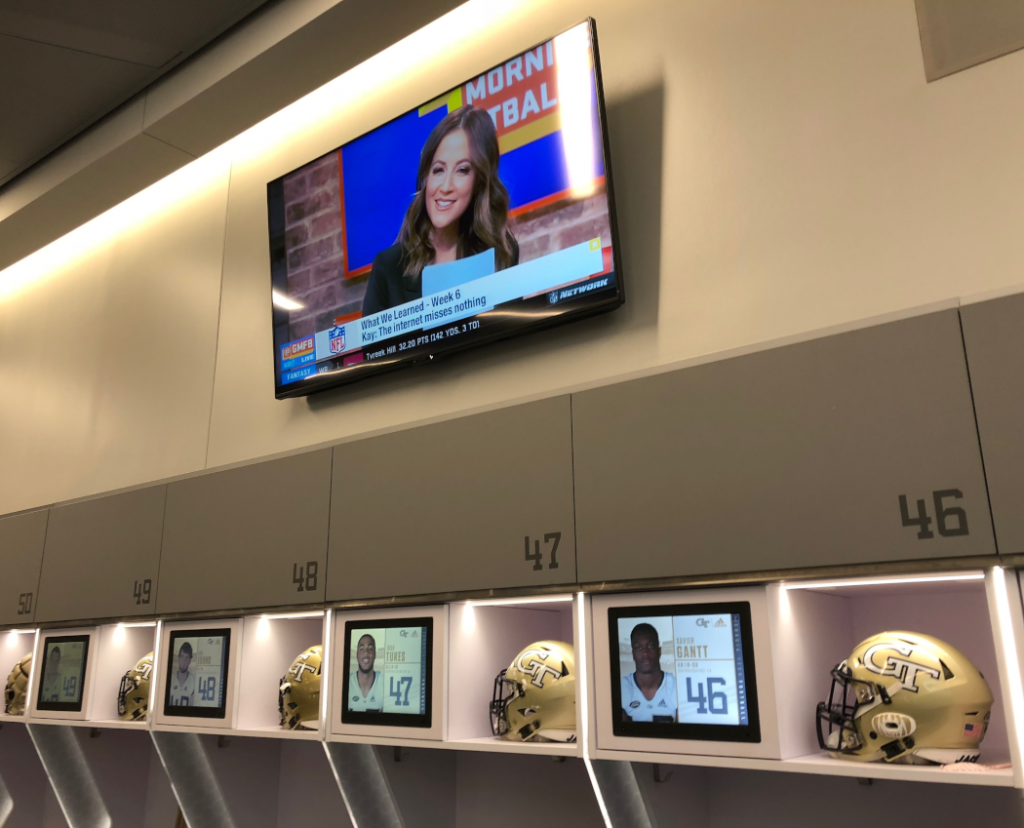Although the big news in college football is usually the appointment of a new head coach, a record-setting performance or new, state-of-the-art facilities, this year it has also been about million-dollar locker room renovations. The “wow” factor plays a significant role even in locker room renovations because it enhances the team’s experience and recruiting operations. From a media perspective, key drivers include IPTV and digital signage.
IPTV systems provide many advantages when compared to older, RF-based TV distribution systems. Because they employ ubiquitous Cat5/6 cabling and network infrastructure, IPTV systems offer greater flexibility in the number and placement of screens than conventional RF systems that require dedicated coaxial cabling. And, because IPTV systems inherently support duplex data communication, programming options include full remote control, interactivity, and even the support of two-way video and audio communication. Even when initial build-outs do not require these features, the ability to add functions such as slo-mo video playback for coaching and random access to archival video clips, or even videoconferencing, ensure that the system is future-proofed and will be able to meet the evolving needs of the athletic program.
When writing about AV installations in sports facilities, my go-to expert is Alpha Video Sports & Entertainment Group’s VP, Jeffrey Volk. In a phone interview, I asked Volk about the pace of conversion from RF-based systems to IPTV systems in the college sports market. “We are still early on, with only about 60 percent of pro sports facilities having made the switch to IPTV,” Volk said. “There is still tremendous opportunity for growth, especially when you include the collegiate market, along with upgrades to 4K, HDR [high dynamic range], and interactive systems for F&B [food and beverage] ordering and other retail outlets.”
Alpha Video Sports & Entertainment Group recently completed work on the newly renovated Yellow Jackets locker room for Georgia Tech. The new AV system includes 17 Sharp commercial-grade flat-panel displays of varying sizes on Chief mounts at key locations, including the entrance, aisle end-caps and hydrotherapy area. A TriplePlay IPTV system and content management system (CMS) takes a clear quadrature amplitude modulation (QAM) feed from the campus cable network and transcodes 20 channels of cable television content into IP streams for distribution on the IPTV network. A quad-channel encoder allows for four additional channels of local content to be streamed on the IPTV system. Two channels of digital signage content, as well as two streams of video-on-demand (VOD) content, are also provided. Recruitment sessions and donor-recognition events, as well as fan and family tours of the facility, all benefit from highlight content available via VOD. Sponsorship messaging and brand advertising can also be displayed as full screen or within an L-bar digital signage layout.
“The TriplePlay system provided the best balance for Georgia Tech’s objectives,” Volk said. “It is powerful and it makes it easy to manage digital signage and other digital media distribution. It offers local controls for the remote selection of channels, and it is scalable so that it can be expanded to other parts of the venue.”
A sound system with four higher-powered Danley Sound Labs loudspeakers, powered by a Danley amplifier and controlled by a QSC DSP, provide sound for the locker room. “Audio sources include the IPTV system, Shure wireless microphones and a wallplate for BYOD audio,” Volk noted. “All audio sources are treated as a single zone throughout the space. Local sound is also available on the individual displays.”
A TriplePlay TripleChoice Education Portal allows for the control of the TriplePlay system and all IPTV set-top boxes, whereas a Crestron control processor and 10-inch touchpanel act as the user interface for control of the individual displays (power, channel, volume) and the sound system (source, volume).
Content for the system includes cable television channels, locally encoded channels and digital signage channels, which primarily act as digital bulletin and message boards for the players. A local HDMI input under several of the displays also allows coaches to input a laptop or other local source directly into the display for additional content.
“The new AV system provides a high-tech feel and finish to the Yellow Jackets’ locker room and provides Georgia Tech with the ability to expand,” Volk said.
As with most large AV systems, digital signage is a key part of the total digital media distribution system. That’s why it is necessary for the AV integration team to work collaboratively with both the IT and Security teams. As with most other digital signage projects, clear and regular communication with all stakeholders throughout the design and deployment process is key to long-term customer satisfaction.
With increased television and social media exposure at all levels of collegiate and pro sports, the locker room has become even more of a focal point for fan and management attention. This, in turn, has created significant and interesting opportunities for designers and integrators with the right team spirit.
